The Riverside museum has 7,500 sq. meters of space that’s distributed over 2 floors. The museum has currently over 3,000 objects that range from prams to South African locomotives to racer bikes to an entire underground subway station. Its position on the north bank of Clyde coupled with its innovative wave design and stunning aesthetics easily makes it one of the most attractive buildings in the architecturally brilliant Glasgow.
The Riverside Transport Museum is free to visit and commands a lot of tourist footfall. The 2011 renovation of the museum has only served to increase its popularity and right now it’s one of the top family friendly attractions in Glasgow. Incidentally, the Riverside Transport museum is an integral part of the restoration of the Clyde corridor (Glasgow’s maritime history is legendary) and Glasgow harbour development project.
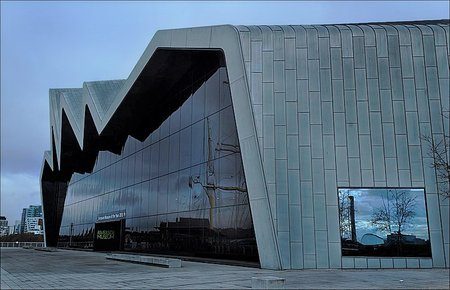
History
The Museum of Transport was born in 1964 in the erstwhile Coplawhill Tram depot in South Glasgow… that’s right after Glasgow’s tram system died in 1962 and the city council thought of preserving its remains. The museum then moved to a location in Kelvin Hall where it remained for a great many years, amassed its collections and grew in popularity. By this time the Transport museum had created simulated streets, shops and interactive areas apart from a collection display of cars, locomotives, rail engines, bikes, prams and myriad forms of transport.
Glasgow city council’s ambitious harbour development project prompted the building of a brand new more gorgeous address for the museum collections. The final move happened in spring 2011 when the museum moved to the north river bank of Clyde into a stunningly designed building created by architect Zaha Hadid (an architect of international repute and first female recipient of Pritzker Architecture award). The Riverside museum (it got a new name as well) cost 74 million pounds to be built and the Heritage Lottery Fund and the Riverside Museum public appeal helped fund the construction and fit out.
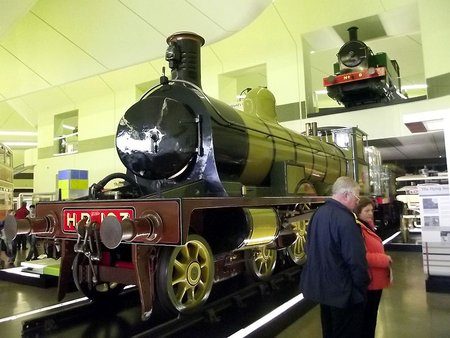
The building has a 36 meter brilliantly glazed façade that reflects the waves of the Clyde River. The new museum is highly energy efficient and can conserve heat optimally. Light levels have been chosen to be low so that the displays inside face minimum damage over the years. The exhibition space inside is column free and open providing superb axial views. All the end walls are glazed so that the cityscape and river sights are seen from inside the museum… thus joining the river Clyde inextricably with the city. Engineers and environmentalists both laud the design and construct principles of the buildings and it has been highlighted in many magazines across the globe.
The Riverside Museum is located where the river Kelvin joins the river Clyde and the museum structure flows from the city to the river in a visually intriguing undulating design. Onlookers may perceive the intention of Zaha Hadid and her team of architects of the museum depicting the connection of the city to the river in a physical and metaphysical sense.
The museum is linear and has openings at both ends and visitors have to more or less follow a straight path and go through all the exhibits before they exit. The external waves on the museum structure seem like a design accessory that denote waves on water but in reality, they accommodate ancillary services and black box exhibits. The central space columns hold most of the museum collections.
The roof of the transport museum is a shining example of the engineering and architectural excellence of Glasgow… the ridges and valleys on the Z shaped zinc clad roof are all of differing heights and widths with uniquely created rafters and fluid transition areas as the roof changes direction frequently. A large number of patinated zinc panels have been used to create this roof and lighting strips follow the seams of the green underbelly of the wavy roof.
The Riverside Museum earned itself the title of Glasgow Guggenheim because of its unique design features. It received more than a million visitors in 2015 and features amongst the best attractions of Scotland. The 2011 renovation also brought in a lot of refurbishment of its collections and the addition of important attractions like the ‘Tall Ship’ managed by the Clyde trust, a giant South African locomotive, storm trooper etc.
What To See & Do
The museum has an outdoor entertainment area, terrace, cafes and walkaway besides a fluidic open exhibition space that holds more than 3,000 exhibits and a large number of interactive panels. Some of the best attractions and exhibits are detailed below.
The Tall Ship
The Riverside Museum’s most popular attraction is undoubtedly the ‘Tall Ship’ that’s permanently moored right outside the museum. The S.S Glenlee is United Kingdom’s only floating Clyde built sailing ship and is one of the 5 Clyde built sailing ships that sailed around the world. it’s owned and managed by Clyde maritime trust. The ship was created at Glasgow port in 1896 and initially functioned as a cargo ship though later she became a sail training ship in the Spanish Navy.
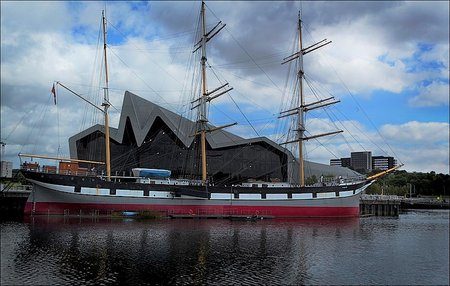
The ship has a special play area designed for kids under the age 5 in the cargo hold and there is even a mouse hunt (called Captain Scallywag’s scavenger hunt) everyday so kids are never going to get bored in here.
The renovated captain’s cabin, mini movie theatre and audio tour of the different sections of the ship (you need to buy the guide) are some of the best activities. Costumed volunteer days, school visits and talks are a regular feature aboard the ship. Pirate theme art and craft workshops are held for free almost every day at noon. Then there is the Treasure Hunt that’s organised on weekdays around 11 a.m. …this is a paid activity though (3 pounds per kid). The tall ship has her own website and you can check out the latest activities there.
The ship is free to visit but groups of 8 or more numbers may have to pay a small entry fee. The Govan ferry crosses the Clyde in the months of July, August and September and it takes off near the tall ship so taking the ferry will be a nice finishing touch to your museum expedition. Technically, the tall ship is not a part of the actual museum as it’s managed by the Clyde Heritage Trust. After the latest renovation of the Riverside museum, the ship (which was an independent attraction before) was berthed next to it. The Clyde Maritime Trust offices and workshops are also hosted in the museum complex now and it offers few other activities like powerboat rides, boat building courses, workshops etc.
Incidentally the tall Ship can be hired for weddings, birthdays, parties etc. and it has enough space to seat 200 for a formal reception. You need to call +44 141 357 3699 for bookings. The tall ship has her own souvenir shop, café and stall selling guidebooks, pamphlets and audio guides. Visiting the ship around its closing hours may allow you to see the first few moments of sunset on board… a beautiful experience.
Timings:
- From 29th October to 28th February the ship welcomes visitors from 10am – 4pm (last admission 3:30pm)
- From 1st March to 28th October the ship welcomes visitors from 10am – 5pm (last admission 4:30pm)
Best Museum Sections
The Graeme Obree section is a great hit amongst visitors especially those who love racing and biking. For the record Graeme was known as the ‘Flying Scotsman’ and he had twice broken the world hour record in the 90’s. He was also famous for his experimental bike design and aerodynamically superior self-manufactured bikes. This section contains a few of his designed bikes and an interesting video play that has Graeme speaking about his life.
To the left near the Museum entrance are 3 recreated streets …a slice of 1938 style Glasgow. They are actually atmospheric reconstructions of entire Glasgow streets complete with cobblestone floor and vintage street lamps. You will find parked cars, shops (Edwardian style photo studio, garage and 1960’s café) and even a truck here all demonstrating the pre-World War II ambience. The streets represent the periods 1890 to 1930, 1930 to 1960 and 1960 to 1980. It’s thrilling to be actually able to enter the shops…a remarkable attention to detail executed by the museum designers.
Then there is Regal Cinema… a cinema reception area of the yesteryears with a screening selection of actual short films mostly pertaining to the history of Glasgow and its transport systems over the last 100 years.
The replica of an actual old underground station (other side of Kelvin Street) exists in the museum and it has a large collection of trains that demonstrate how locomotive manufacturing was an important part of Glasgow. Video footage of old subway activities keep on playing here to give the place a genuine feel.
Kids will love the Stormtrooper that sits jauntily in the 1980’s toyshop window. This full-size rare fibreglass replica of a storm trooper was actually cast from the costume used in Star Wars Episode IV.
Clyde Room is undoubtedly one of the most interesting sections of the museum as the river Clyde and Glasgow shipbuilding industry and its engineers and workers all had a huge contribution to the world of marine trade and engineering. Once upon a time the label ‘Clyde Built’ had huge significance. As you check out the 250 detailed ship models most built in the 1:48 scale, you will understand why. Look out for the Comet of 1812, Hood ship models, Queen Elizabeth, Queen Elizabeth 2, Queen Mary etc. Some of the ship models were actually made by the firms who created these ships… as promotional tools.
The Pan Am Flight Memorial that plays tribute to the 243 passengers and 16 crew of the Boeing 747 which crashed …is one of the most moving parts of the museum. 11 residents of Scotland were also killed when the plane crashed on the town. For the record, Pan Am Flight 103 was bombed in 21 December 1988 in an incident known as Lockerbie bombing… it’s said to be the most violent terror attack in UK’s history.
The Heavy Collections area beyond the mezzanine floor is one of the most extensive parts of the museum. There in an entire recreated railway station here worth a number of railway coaches and carriages.
There is a separate section devoted to a collection of old trams and buses all decked up in the signage of the Glasgow Corporation.
There is a Wall of Cars which literally is a wall supporting 30 or more cars that stand on beams. There is a Bicycle Area which has bikes suspended in a hanging circle over your heads… yet another design innovation!!
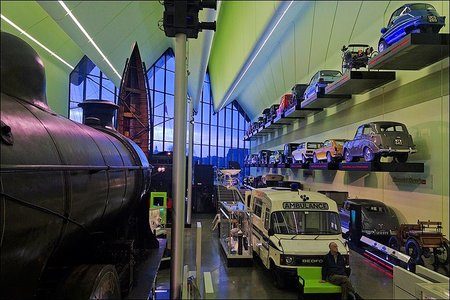
Most of the vehicle models allow engagement that is you can touch and sit inside them and every section has an interactive exhibit where you can learn new facts, take quizzes and watch videos… there are almost 90 such interactive screens inside the museum!
You will love the unexpected surprises that the museum springs up like the collection of Pakistani Truck art and a series of emergency service vehicles including a police Ford Granada and a Ford Fiesta that has been crash tested. The horse drawn carriages with the full-sized stuffed horses are charming to say the least.
Also, there is the school bus that seems to have stepped out from the popular TV Show Balmory. Kids will love the interactive exhibits and the special play areas including one that simulates a traffic lights and crossing. There is also a huge sandbox at the entrance of the museum where kids can play in.
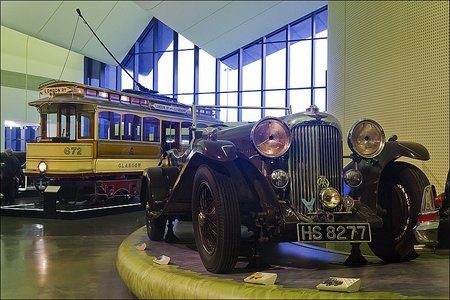
As mentioned earlier, this is a unidirectional museum with one entry and one exit and it’s very extensive (to say the least). This means that some visitors actually feel relieved when they reach the set of steps at one end of the museum… that lead up to the ‘Transport Café’. You will get gorgeous views of the exhibits from the café. There is a refreshments corner on the tall ship as well as on the first floor.
Right at the entrance of the museum there is a shop selling souvenirs, gifts and unusual trinkets… all allying to the Transport theme. Once you are done with your museum visit, don’t forget to enjoy a pretty walk along the banks of the Clyde. Or you can climb up to the terrace for some beautiful river views.
The Riverside Transport museum has achieved commendable accessibility and it is especially sensitive towards sensory impaired visitors. All the audio content inside the museum have special handheld displays with induction loops that are suitable for hearing impaired visitors. 10% of the displays are designed for visitors with sensory defects and there are tactile trails for visually impaired visitors. The floor plans, museum information signage and digital display elements are available in multiple local and foreign languages.
Admission & Hours
The museum is free to enter though the staff (especially those around the tall ship) ask for donations and sometimes do that insistently. The usual donation amount is 5 pounds.
The opening hours for the Riverside Museum is 10.00 a.m. to 5.00 p.m. from Monday to Thursday and Saturday while on Fridays and Saturdays the museum is open from 11.00 a.m. to 5.00 p.m.
Location & Contacts
The Riverside Museum sits at Pointhouse Quay on the north banks of the River Clyde bang opposite Govan where River Kelvin meets Clyde. The museum is about 1 km away from the Scottish Exhibition and Conference Centre. Incidentally this is a historic location that has been operating as a ferry crossing since the middle ages. The erstwhile A&J Inglis shipyard used to exist here and other shipyards like Robert Napier and Harland Wolff were also nearby. In fact, if you cross the river you can actually see an operational shipyard i.e. BAE’s unit in Govan.
Infuriatingly, most Glasgow cab drivers get confused when asked to be taken to 100 Pointhouse Place. It’s better to walk there from Byres road in 15 minutes and you will find plenty of good signage helping you. From Glasgow city centre, the museum is a good 45 minutes’ walk away and the path is exposed to the vagaries of weather. If you are taking your own car then the museum is near the Clydeside Expressway and there is a huge (chargeable and chaperoned) car park outside. The parking is quite expensive …more than 3 pounds for two hours so it might be a better idea to use public transport.
The Glasgow city bus Riversider rotates between the George square Kelvingrove Art gallery, SECC and the Riverside museum and it’s a good option for reaching any riverside attraction… the bus runs once in every 30 minutes. All Glasgow Bus tours including hop on hop off buses stop at the Riverside museum.
Pedestrians and bicycle users will be able to use the River Clyde walkway to travel from Patrick station, Kelvingrove Gallery and Museum and Kelvin Hall, Scottish Exhibition and Conference Centre to the Riverside Museum. There are Bicycle racks near the museum.
Many visitors (especially those who visit between July to September) cross across the Clyde river using the historic ferry service into Govan. If you do so then don’t forget to indulge in the hearty fry ups that’s served at the Café 13 near the riverbank. The ancient Parish church of Govan with its historic stones is also well worth a visit.
Exploring the Riverside Transport Museum and tall ship should honestly take up 4 to 6 hours and the rest of the time can be spent enjoying a good walk along the riverside. For visitors with tighter schedules fitting in the Kelvingrove gallery and the Riverside museum in a single day might work.
There are cafes at the Riverside Transport Museum and the Tall Ship but they have limited though good menu selections. There is the 279 Café Bistro at Dumbarton Road but that’s about 600 meters away while the Roastitt Bubbly Jocks restaurant (hearty British food) is about 700 meters away. Byre’s Road has a couple of good places like Little Curry House, Number 16, Usha’s street food etc. You can also bring your own food hamper and have a self-styled picnic near the river banks.
100 Pointhouse Place, Glasgow, G3 8RS
Phone: 0141 287 2720; Email: [email protected]; Website
 A travel addict. Still celebrating the day when he quit his high-profile corporate job to pursue his passion for travel writing.
A travel addict. Still celebrating the day when he quit his high-profile corporate job to pursue his passion for travel writing.